Topic: Earth Revolution
Earth Revolution
Which motion causes the Coriolis effect on Earth?
(1) revolution of Earth around the Sun
(2) revolution of the Moon around Earth
(3) rotation of Earth on its axis
(4) rotation of the Moon on its axis
How many days during one year is the Sun directly overhead at noon in New York City?
(1) one
(2) two
(3) three
(4) zero
Seasonal changes on Earth are primarily caused by the
(1) parallelism of the Sun’s axis as the Sun revolves around Earth
(2) changes in distance between Earth and the Sun
(3) elliptical shape of Earth’s orbit around the Sun
(4) tilt of Earth’s axis as Earth revolves around the Sun
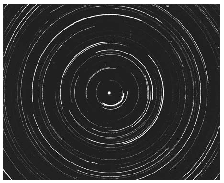
Which celestial object is shown in the photograph near the center of the star trails?
(1) the Sun
(2) the Moon
(3) Sirius
(4) Polaris
Which diagram best represents the tilt of Earth’s axis that causes the Northern Hemisphere seasons shown? (Diagrams are not drawn to scale.)
(1) 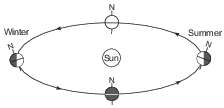
(2) 
(3) 
(4) 
Which diagram best represents the regions of Earth in sunlight on June 21 and December 21? [NP indicates the North Pole and the shading represents Earth’s night side. Diagrams are not drawn to scale.]
(1) 
(2) 
(3) 
(4) 

At positions A, B, C, and D, the north end of Earth’s axis of rotation is pointing toward
(1) Betelgeuse
(2) Polaris
(3) the center of the Milky Way
(4) the center of our solar system
Which statement best explains why stars viewed from the Northern Hemisphere appear to revolve around Polaris?
(1) Polaris rotates on its axis.
(2) Earth rotates on its axis.
(3) Polaris revolves around Earth.
(4) Earth revolves around Polaris.
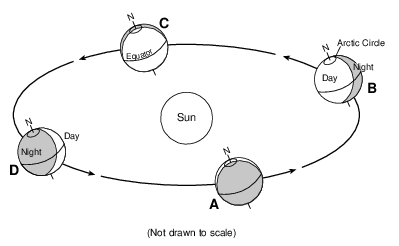
At each position in Earth’s orbit, the North Pole is pointing toward
(1) Pollux
(2) the Sun
(3) Polaris
(4) the Moon
Which factor is a primary cause of seasonal changes on Earth?
(1) change in Earth’s distance from the Sun
(2) change in the rate of Earth’s rotation
(3) wobble of Earth’s axis
(4) tilt of Earth’s axis
The time-exposure photograph shown below was taken by an observer in the Northern Hemisphere to record the apparent paths of stars.

The name of the bright star near the center that the other stars appear to be circling is
(1) Polaris
(2) Alpha Centauri
(3) Betelgeuse
(4) Deneb
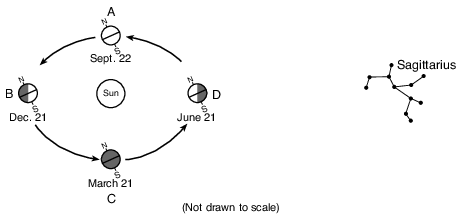
At which lettered position does Sagittarius appear highest in the sky at midnight to observers near Earth’s equator? [1]
Lettered position:
Allow 1 credit for D or June 21.
On the diagram in the image provided, place an X at a location on Earth’s surface where the Sun was directly overhead at some time on December 21. [1]

Allow 1 credit if the center of the X is located within the area between the dashed lines on either side of the Tropic of Capricorn (23.5° S).
• Note: It is recommended that an overlay of the same scale as the student answer booklet be used
• to ensure reliability in rating.
• 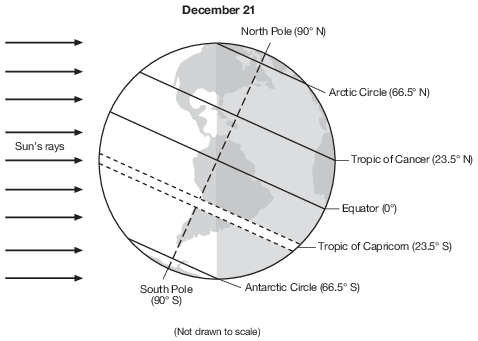
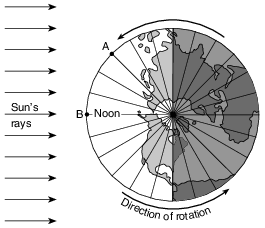
Identify one date represented by this diagram. [1]
Allow 1 credit. Acceptable responses include, but are not limited to:
• — March 19 or March 20 or March 21 or March 22
• — Sept. 21 or Sept. 22 or Sept. 23 or September 24
• — vernal equinox or autumnal equinox
• — equinox
• — first day of spring or first day of fall
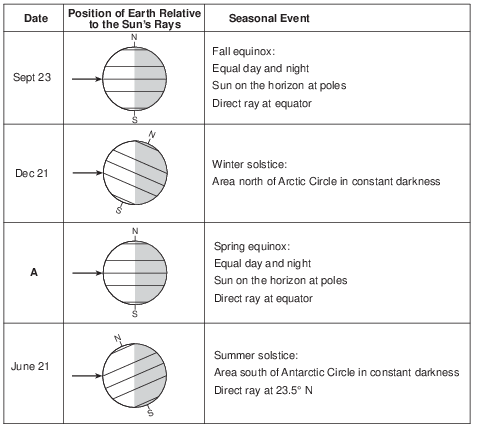
Identify one possible date represented by letter A. [1]
Allow 1 credit for the correct month and day of March 19 or March 20 or March 21 or March 22.
